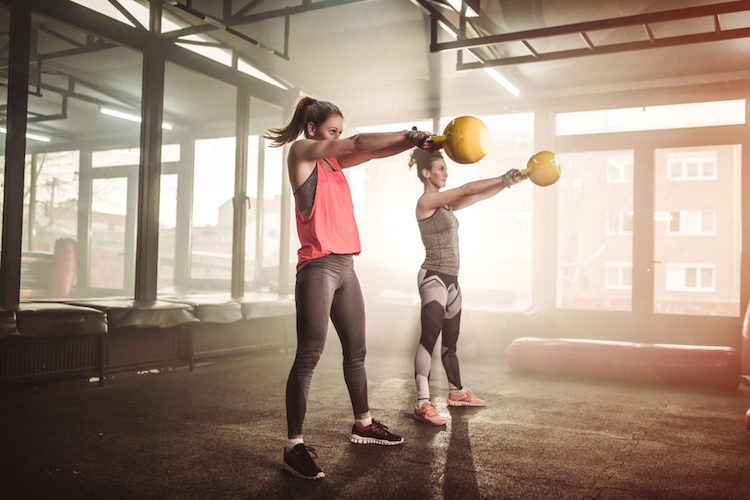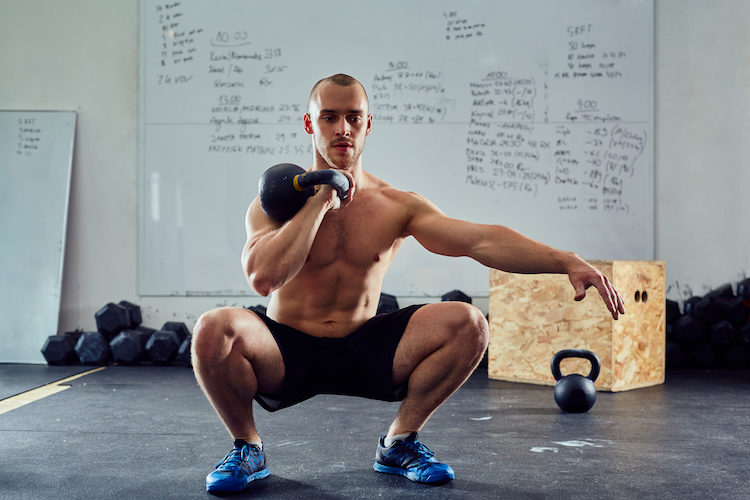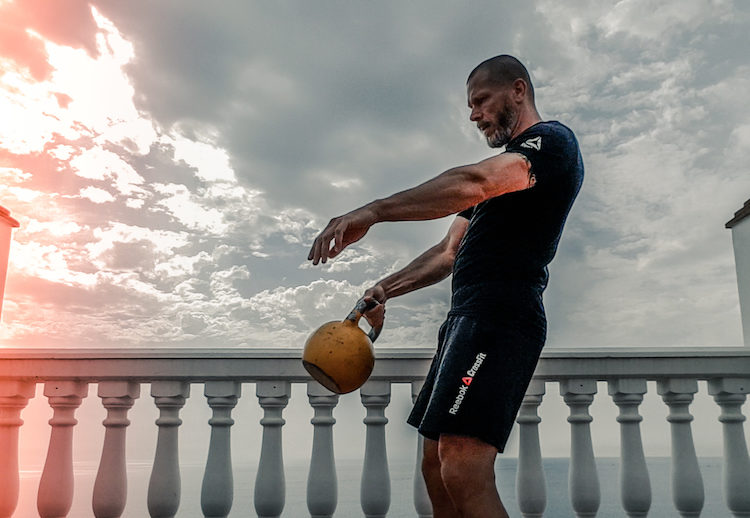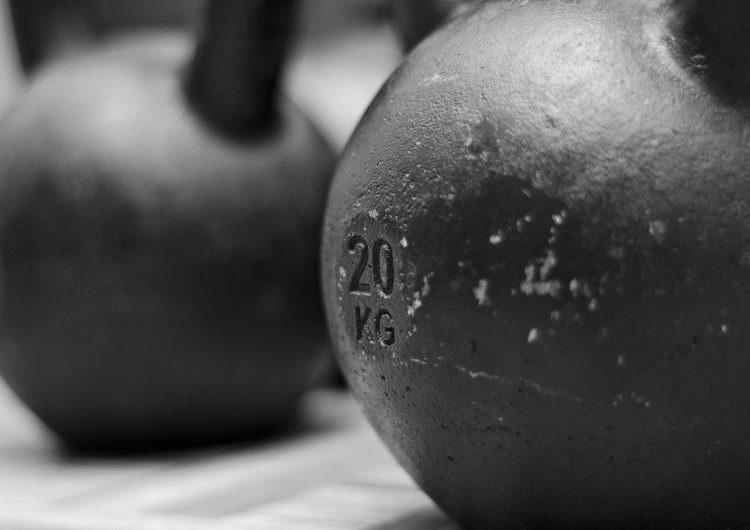So, you’re a powerlifter. You spend most of your time with barbells, plates, and more barbells. Hey, I feel you: so do I. But eventually, we all hit the dreaded plateau: no matter how hard we try, we can’t seem to budge our bench numbers, and our squat doesn’t want to go anywhere. Or, you’re progressing on two of your lifts, but that third is eluding you.
We’ve all been there. But you don’t have to stay there. Because when it comes to plateau-busting, dropping the barbell and picking up some kettlebells can do wonders for your powerlifting. That’s right: explosive movements actually require a great deal of control, and the power needed to move kettlebells can have carryover to the big three.
Why kettlebells? The low-to-no impact nature of using the odd-shaped implements will crank up your intensity while avoiding increased stress on your joints. Which, as powerlifters, we know are always one lift away from creaking anyway.
And using kettlebells as finishers is extra helpful. What’s a finisher? You’re about to find out.
[More from the author: A Low-Impact, 15-Minute HIIT Kettlebell Circuit]
Before You Start
These moves are intended to follow a heavy lifting day (hence: finisher). You don’t want to use all your energy before your big lifts, but you do want to squeeze every last bit of productivity you can out of your session. You do want to leave your body feeling spent while, ironically, kick-starting your recovery. Getting your blood flowing, like you will with these kettlebell finishers, will help you recover while also helping you bust through that plateau. And, as with all workouts, make sure you’re cooling down and stretching afterwards, to hasten recovery even further and make your next lifting session that much better.

Kettlebell Finishers for Deadlift Workouts
So you’ve finished your deadlifting for the day. That bar was loaded and you’ve hit up your accessory work and you’re already pretty gassed. Here’s where your finisher comes in.
For each option, select a kettlebell weight that’s moderately heavy, and that you can confidently execute (even when fatigued) with impeccable form.
Option One: EMOM Kettlebell Swings (Two Hands, Ten Minutes)
Set a timer on your phone or whatever gadget you use (a stopwatch will do). Set up with a kettlebell about a foot and a half in front of you, with your feet about hip width apart. When you start the stopwatch, drag the kettlebell behind you and through your legs.
Leading with your hips, not tugging with your arms, explode out so that the bell flutters in front of you. Keep your knees soft and your core braced. Your elbows should be soft (not quite bent, but definitely not locked out) throughout the movement, and you should have a solid enough grip on the kettlebell where you can flutter your fingers through the bell if you wanted at the top of the lift.
- Complete ten quick, efficient, hip-led swings. Do not arch your back/lean backwards at the top of the swing.
- Rest until your stopwatch hits the minute mark.
- Begin ten more swings at the top of the minute.
- Repeat for ten minutes. This will total 100 swings.
[Learn more: 6 Powerlifters Share the Most Underrated Accessory Exercises.]
Option Two: Alternating Kettlebell Swings (Five Minutes)
This version of the finisher will have you gasping for air in mere minutes (and improving your ability to lift efficiently and powerfully when you get back to the barbell).
You’ll set up the same as with the two-handed swing above, but this time, you’ll be alternating hands. You’ll start with one hand, swinging just like you do with two: soft elbows, soft but steady grip. Let the bell stay suspended in air as you switch hands, completing the swing and seamlessly going into the next one with the opposite hand.
Once again, set a timer.
- Complete twenty hip-led swings, again, refusing to lean backwards at the top of each. The twenty is inclusive of each swing: ten per hand. You might want to count out loud for this one, otherwise you could get lost.
- Rest until your stopwatch hits the minute mark. Since you’re doing twenty swings, this will give you significantly less time to rest.
- Being twenty more swings at the top of the minute.
- Repeat for five minutes. This will total 100 swings, but in half the time.
[One-handed swings are one of these 10 Kettlebell Exercises Every Athlete Should Master]

Kettlebell Finishers for Squat Workouts
Again, after your squat-dominant workout, select a kettlebell weight that’s moderately heavy but ensures that you can execute each lift with form that would make Captain Marvel proud.
Option One: Kettlebell Racked Squat (Unilateral)
Sure, you could hike two kettlebells, one in each hand, into rack position, but we’re going to do one at a time here. Why? Unilateral work will present a greater challenge to your core. So.
To get the bell into rack position, you can clean it if you can do so with proper form, or you can use one hand to help the other position it. Grip the handle off to the side, so that your thumb and index finger are cradled against the curve of the handle. This grip will help ensure that your wrist remains straight and not pulled back by the weight of the bell. It also ensures that your forearm, where the bell is resting (alongside your front deltoid), won’t bear the brunt of the weight.
- With one bell in front rack position, proceed to squat to depth for 12 reps.
- Without rest, switch the bell to the other arm.
- Complete 12 reps.
- Rest for only 30-45 seconds.
- Repeat sequence 3 times.
Option Two: Goblet-Style Lateral Lunge
You have two choices here: you can hold the bell over the center of your chest with both hands, or you can keep it in rack position with only one hand. The difference? You guessed it: how much you want to involve your core. Either way, this will tax your core: it’s a difference of degree.
Whichever setup you decide for your upper body, the need-to-know with your lower body is this: whenever you are performing a lateral lunge, do not let your leading knee (the knee you’re lunging out to the side with) track over your toe. Find a position where you’re lunging leg is close enough to your body that you can sit back into the movement (“bring your butt back” is the cue here) but far enough away so that your knee doesn’t stray farther from your body than your toes. Keep the heel of your static leg on the ground. And don’t forget, as ever, to breathe.
- Sitting back into the lateral lunge, complete 8 repetitions on one side (do not alternate. Alternating will make it harder for many to keep their form/their literal stride).
- Pausing only to re-center your body, complete 8 repetitions on the other side.
- Rest for 30 seconds.
- Repeat sequence 3 times.
Kettlebell Finishers for Chest Workouts
Aren’t kettlebells for lower body movements, you ask? Only if creative, you are not, Yoda responds. These kettlebell chest workouts don’t look as explosive as their lower body companions, but the amount of grip strength and control they demand will have your muscles shaking, just the same.
Option One: Bottoms Up Floor Press (Unilateral)
The bottom of the bell is usually face down: or, when we’re swinging, facing sometimes down, sometimes sideways. We’re used to holding the handle of the bell. So what’s the big deal about bottoms up presses?
Laying down on a mat, you’re going to set up like you normally would for a floor press. Except, you’re going to take the kettlebell and hold the handle not in clean style (where your hand would be threaded through the handle and the bottom of the bell would be facing the ground). Instead, you’re going to grip it like a barbell: solid in the center of the handle. But, here’s the catch: you will position the bell so the handle (and your hand) are at the bottom of the kettlebell. The bottom of the bell will be facing the ceiling. Which suddenly gives you a huge imbalance, and huge incentive to focus, focus, focus on your grip.
- Keeping that bottoms up kettlebell position, complete 12 floor presses on one side.
- Pausing only to reset, complete 12 floor presses on the other side.
- Rest for 60 seconds.
- Repeat sequence three times.
[Learn more: 3 Bottoms Up Kettlebell Exercises to Improve Lifting Technique.]
Option Two: Kneeling Bottoms Up Shoulder Press
As powerlifters, we too often neglect straight-up shoulder work. But shoulder strength and health is absolutely crucial to a strong squat, deadlift, and (more obviously, perhaps) bench. Use this finisher after benching to tax your shoulders and strengthen them so that the next time you go to bench, you’ll be closer to busting that plateau.
The setup is the same as above, except this time, you’ll be kneeling. Keep your chest tall and squeeze your glutes and quads throughout the lift. Just as above, hold the kettlebells in the bottoms up position. Go slow, and go light, at least until you get the hang of the movement.
- Complete 12 kneeling bottoms up shoulder presses.
- Rest for 30 seconds.
- Repeat sequence three times.
Wrapping Up
Whatever option you chose, you should be well on your way to both recovery and strength-building. Powerlifting plateaus aren’t going to stand a chance against you with these kettlebell finishers. And as an added bonus: using these moves when you’re already feeling wiped is only going to strengthen your mental stamina. And that, we know, is the hallmark of all solid powerlifters.
Editor’s note: This article is an op-ed. The views expressed herein and in the video are the author’s and don’t necessarily reflect the views of BarBend. Claims, assertions, opinions, and quotes have been sourced exclusively by the author.
Featured image via baranq/Shutterstock


